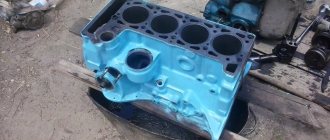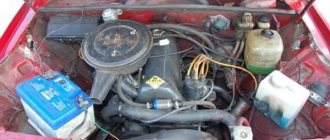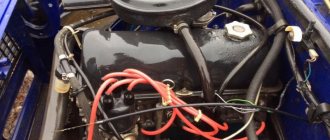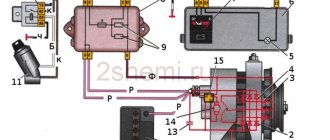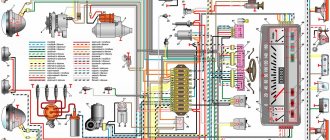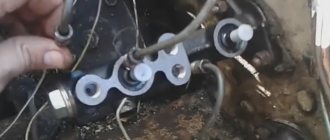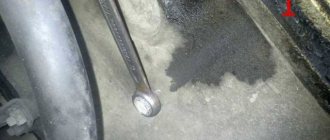One of the most popular is the VAZ 2103 engine, which runs on gasoline. Its displacement is 1.5 liters, which makes it possible to produce from 68 to 77 horsepower of maximum power, depending on the year of manufacture, which is achieved at an engine speed of 5600 per minute.
A huge number of cars from domestic manufacturers were equipped with such an engine, which is why it became quite popular. In fact, like all VAZ engines, it is a redesigned version of the 2101 engine, so they have quite a lot in common, but also have distinctive qualities.
Specifications
| Engine capacity, cc | 1452 |
| Maximum power, hp | 68 — 77 |
| Maximum torque, N*m (kg*m) at rpm. | 103 (11) / 3400 104 (11) / 3400 105 (11) / 3500 106 (11) / 3400 112 (11) / 3500 |
| Fuel used | Gasoline Gasoline AI-92 |
| Fuel consumption, l/100 km | 7.8 — 10.3 |
| engine's type | In-line, 4-cylinder |
| Add. engine information | Carburetor |
| Maximum power, hp (kW) at rpm | 68 (50) / 5600 71 (52) / 5000 71 (52) / 5600 72 (53) / 5600 77 (57) / 5600 |
| Compression ratio | 8.5 |
| Cylinder diameter, mm | 76 — 82 |
| Piston stroke, mm | 66 — 80 |
| Number of valves per cylinder | 2 |
Peculiarities
Despite the fact that domestic manufacturers almost never made significant changes to the design of their power units, the VAZ 2103 engine block combined a fairly large number of developments. The camshaft is mounted from the 2101 engine, which provides a raw journal between the cams of the second cylinder in the shape of a hexagon.
Certain changes have also been made to the cylinder head in the form of a 2 mm step in the combustion chamber, which is obtained by milling. The gas distribution mechanism is driven by a chain, and the attachments in the form of a pump and generator are moved by a belt.
The crankshaft is installed from the 2101 power unit with a crank radius of 40 millimeters.
The displacement of the VAZ 2103 engine has increased compared to the previous version. This was achieved by increasing the cylinder block by 8.8 millimeters. Thanks to this solution from the manufacturers, an increased piston stroke was obtained.
Many people wonder how much this power unit weighs, and the weight of the VAZ 2103 engine is 120.7 kilograms. A weight of almost 130 kilograms was achieved thanks to the installation of a lightweight cylinder head.
The VAZ 2103 engine number is located on the lower shelf of the air intake, which is located on the right in the direction of travel of the car, so finding the marking plate will not be difficult.
Tuning the VAZ 2103 engine
Boost engine 2103
There are a lot of methods for modifying the VAZ 2103 engine, like all classics, from boring to a compressor with turbines, but let’s start in order. How to boost the VAZ 2103 engine, the cheapest and simplest tuning of the VAZ 2103 engine was and remains boring the cylinders by 3 mm under a 79 mm piston from a VAZ 21011 or from a VAZ 2106, the output is 1.6 liters. Sharpening further, at 82 mm, will not work due to the too thin walls of the block. To further increase the volume, you need to increase the piston stroke to 84 mm. Increasing the volume in this way reduces the maximum operating speed; a low-end engine is not the best choice for racing, but still. To increase the power of the VAZ 2103 engine by piston stroke, install a VAZ 2130 crankshaft, and also use TRT pistons, the connecting rods are seated to 134 mm. The disadvantages of TPT pistons are their lower strength compared to standard ones, the thermal load on the ring and the likelihood of piston burnout.
Engine boring 2103
- larger diameter piston, standard stroke 1.6 liters. 79x80 ~75 hp Maximum torque ~115 Nm at 3000 rpm With this configuration we get exactly the 2106 motor - larger diameter piston, standard stroke 1.7 liters. 79x84 ~ 80 hp Torque engine, non-racing configuration.
How to boost a VAZ 2103 engine by refining the cylinder head
The three-wheel engine uses the VAZ 2101 cylinder head, the main disadvantage of which is that it was developed for small-volume units. Accordingly, the flow sections of the channels do not correspond to the increased volume; this must be corrected by boring and polishing the channels. Polishing and boring the VAZ 2103 cylinder head channels and manifold will significantly reduce intake resistance, engine power increases by 10% throughout the entire range. How to polish and which shafts to select is described in the article “Tuning a VAZ 2101”, due to the identity of the engines, all this applies to the engine of the Lada troika. The modification of the 2103 engine does not end there; a correctly selected camshaft for the 2103, as well as a modified head, can produce more than 100 hp.
Camshaft on VAZ 2103
The rule for choosing a camshaft is simple: in a lower configuration, when the piston stroke is large and it is larger than the cylinder diameter, you need to take a lower shaft with a phase of up to 270, a larger valve lift. Such an engine will turn out to be quite high-torque, urban and will drive much better than the standard, while the high speeds will disappear. Which camshaft to choose for the lower ends, Estonets 1, Nivovsky 213 or something similar in parameters will do. For the top configuration, we accordingly select a wide-phase top shaft with a large valve lift. The standard head without modifications will accept the Mastermotor 48 camshaft, OKB Engine 480 and the like. More wide-phase ones will require additional work. The disadvantages of shafts with a wide phase are traction at the bottom; the angrier the shaft, the worse the ride at the bottom and the more uneven the idle, but by losing the bottom we gain high power at the top. It’s up to you to decide which direction to move and whether it’s worth moving at all; the basic and most popular principles of boosting the 2103 engine were presented to you as simply and easily as possible.
Classic compressor
The 2103 compressor is an excellent option for inexpensively inflating Lada cars; stores have ready-made installation kits with a pressure of 0.5 and 0.7 bar from an auto-turbo. Installing a 0.5 bar compressor on a classic is quite simple and requires minimal modifications; paired with a modified cylinder head, the engine produces more than 125 hp. This method is opposed by the price of all activities.
Turbo classic
This is, without a doubt, the most expensive and unprofitable method of boosting a VAZ 2103 engine. Your first cost will be converting the engine to an injector. Then we purchase a turbo kit for the classic, prices start from $1.5 thousand. Most kits are built on the basis of the Garrett GT17 turbine, they come without modification of the piston, but blow up to 0.5 bar. In this case, a classic compressor is more rational. In the case of a total modification of the 2103 engine, with the replacement of the piston, installation of the correct turbo shaft (phase 270-280, maximum lift), this kit will produce up to 1.2 bar with a power of more than 140 hp. The cost of such alterations will cost more than the car itself, even without taking into account the chassis, gearbox, brake system and other things.
